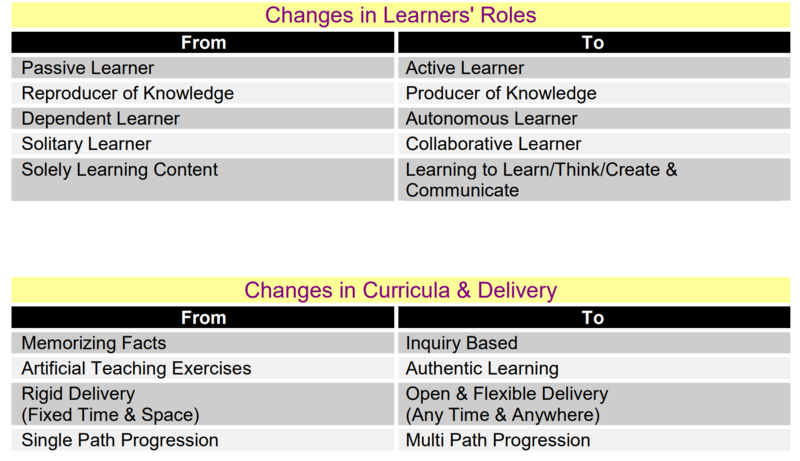Jennie J. Jones’s Updates
Update 6: Moving Away from Didactic Pedagogy to More Authentic Learning
New technological skills and trends are often held tightly in the hands of students, while schools trail behind somewhere in the 19th or 20th Centuries. The practice of didactic teaching, where the students face forward and listen passively to the "font of knowledge" at the front of the room, is a ubiquitous strategy employed by many schools across America. In some ways, didactic teaching can be helpful to create structure and schema or provide a much-needed academically focused vocabulary for students to make connections in their lessons.
However, public education often seems like a dinosaur to our most important clientele, the students. If we are to provide skills that they will actually need to the citizens of the future, schools as institutions need to move into more authentic and transformative teaching practice to instill a sense of intrinsic motivation, curiosity and autonomy focused on student learning. Information and Communications Technology (ICT) has become more prevalent in schools that want to be seen as preparing students for 21st-century jobs. However, when teachers aren't provided the skills to implement higher order thinking skills with the technology, laptops, and PowerPoints often are no better than didactic methods in digital disguise.
Voogt and Pelgrum(2005) suggest that students move to different forms of educational experiences:
- less activity prescribed by the teacher
- more activity determined by the learners themselves working in small groups
Creativity flourishes when students are allowed to share more of the power to determine what and how to learn. Further Prof. Shyamal Majumdar, Ph.D. recognized that because of this educational shift, learners will have much more agency for their own learning "as they seek out, find, synthesize, and share their knowledge with others." (Majumdar, 2015, p 2).
The shift will require that teachers be trained in the many modalities of technology and how to use them in authentic and transformative ways. This will likely require much professional development and a strong district administration that would support the implementation of such skills in the classroom. Likely, it will be very important for districts to be willing to cut the scope of what curriculum is covered and how much. Students who work in groups often take much more time in learning concepts, but their learning is much deeper as a result. Schools would have to make a serious shift from covering curriculum to deeply learning how to create and synthesize information within a collaborative environment between teachers and students.
The teacher will require many skill sets in order to implement this shared model of learning where technological awareness, multimodal supports, communication skills, and the ability to guide students in differentiated, student-led projects all form the cornerstone of honing 21st Century skills in the classroom.
Majumdar, S. (2015). Emerging trends in ICT for education & training. Gen. Asia Pacific Reg. IVETA.
Voogt, J.M., & Pelgrum, H. (2005). ICT AND CURRICULUM CHANGE. Human technology: an interdisciplinary journal on humans in ICT environments, 1, 157-175.
.png?Expires=1765613295&Signature=dvPuQNXKVZ5vKtPZ~H3~LaTHJrX9FvQrFHneZ1fkxy6y6i6RbAWKedN-vsqfk-lBpA6uJb2ZZu9SdeAokhNLZypNiqIVRpsXeOyNM6hydbBkgWzlVcFzDd55nPyXL4bm~elckJ-DzMdA6YXgwBIGoH2xe98TqB--fQethS1W2qtS85WIeUY4fA4Yuloa3H3NzA22fjNgUhXQvM8dzgGygus~KiynyENNm56QKlawkikA9WzY~IKji43-K~TQZ3oIniONA6QhA8umkaj-S9xAP9WRjnxuCKzmAOh1z13eL1BEn99hxNwdOu-EurQUa6gykskehBNiP5ahd3y51aqpkA__&Key-Pair-Id=APKAJELYXGUCCDL7FUQA)



That's a great point about authentic learning! It's so true that kids often know more about tech than we give them credit for. Thinking about more engaging learning experiences, I recently saw something that reminded me of the creativity you mentioned. It was this fun game, Crazy Cattle 3D, and while it's just a game, it made me think about how we could incorporate more interactive and engaging elements like that into education. The kids would definitely be more involved!
Shifting from didactic pedagogy to more authentic learning is like moving from reading about kalimbas to actually playing one—real understanding comes through hands-on, meaningful experiences.
Shifting from didactic pedagogy to more authentic learning opens up exciting, real-world experiences for students. Imagine integrating Drone Photography Birmingham into lessons—hands-on, creative, and truly engaging!
Coin Master offers nonstop excitement for players who love spinning and building. You can enjoy daily events, win massive coin bonuses, and challenge your friends in battles. Don’t miss out on extra chances—check out our daily spin rewards and keep your village growing strong!
In hole io online swallowing a skyscraper or an entire neighborhood feels powerful and exciting, especially as you slowly dominate the map.
word vs word is an exciting single-player with bot word puzzle game where you battle in real-time matches.
idle breakout is my go-to game during study breaks. it’s simple but so satisfying!
geometry dash unblocked is the best way to pass time and have fun!
The randomization in bitlife ensures no two games are the same, offering endless replayability and surprises with each playthrough.
Coin Master offers nonstop excitement for players who love spinning and building. You can enjoy daily events, win massive coin bonuses, and challenge your friends in battles. Don’t miss out on extra chances—check out our daily spin rewards and keep your village growing strong!